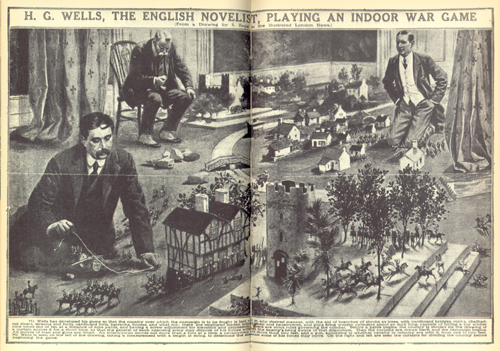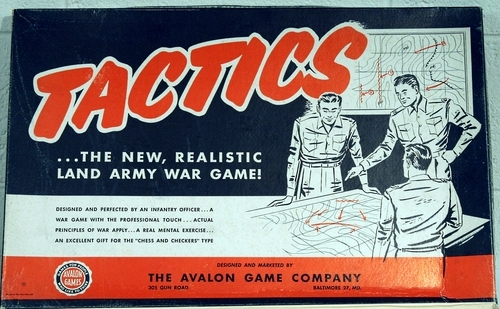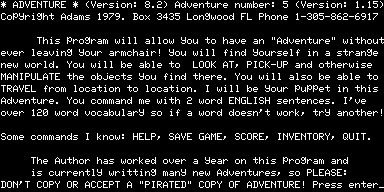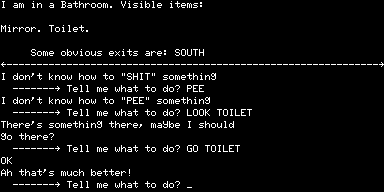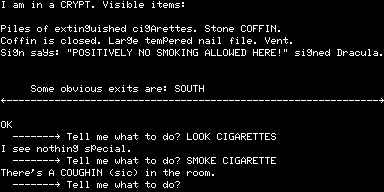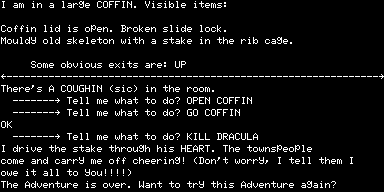Having introduced my ideas about what constitutes a ludic narrative in my last post, I’d now like to set that aside for just a little while to consider games in another way.
I define a game as a dynamic system which, in contrast to other art forms (sorry, Roger Ebert) which are “merely” consumed and appreciated, requires active input from one or more players to make it go. I realize that such a definition excludes some things often referred to as games, such as children’s free-form “games” of pure make-believe, and potentially lets in some questionable things, such as some interactive art installations. We’ll just have to use a bit of common sense in applying this definition, and where necessary fall back yet again on good old George Lakoff.
I think we can usefully divide a game into three components. First we have the system itself, the network of rules which govern play and, indeed, which largely mark the game as a game. Next we have what Noah Wardrip-Fruin calls the surface, the player’s method of getting data into and out of the underlying system. Taken at its most superficial, the surface of a given game can often be described in a few words: a poker player uses the playing cards for both input and output, for instance, while a player of a modern computer game likely uses the mouse for input and the monitor screen for output. However, I really mean for the surface component to be taken more holistically, to be used to cover not only the bare technology of interaction but also the character of that interaction and the scope of affordance (in game-designer speak, the “verbs”) that is allowed. This seems only reasonable; a first-person shooter, for example, provides its own very distinct experience at the surface level, one that is in some ways richer and in some ways more limited than, say, a point-and-click graphic adventure game. And finally, we have the fictional context of the game, the imaginary event being simulated. (Many games are, of course, based on real-life events, but even these must play out anew in the players’ imaginations.) It’s this aspect of games that is one of the keys to my idea of ludic narrative.
The first thing to note about fictional context is that its relative importance to the experience of a game can vary tremendously. In some cases context may not be present at all. Poker and most other traditional card games, for instance, exist purely as abstract systems to be manipulated. Many other games do provide some sort of context, but said context has little relation with the system of rules, being (to use some board-gamer parlance) essentially “painted on” and quickly forgotten during actual play. The board game Monopoly is a classic example of this phenomenon that virtually everyone knows. My wife and I actually play quite a lot of board games, including many examples of so-called “Euro-games” whose elaborate themes and colorful artwork almost always have nothing whatsoever to do with the actual experience of play. I don’t mean this as a criticism; I think I could play Dominion every day for the rest of my life and not tire of it. In this blog, though, I’m obviously most interested in games that have a context that is very important to the player’s experience.
We can legitimately call all such games simulations, in that their rules systems simulate events occurring in a fictional place that exists only in the imagination of the players. They can perhaps trace their oldest progenitor to ancient China, where Sun Tzu, the author of The Art of War, developed a game which simulated the maneuvering of armies in order to help his students learn strategy. It is possible that this game, which Sun Tzu named Wei-Hai, evolved into the abstract strategy game Go over the centuries. Similarly, the modern game of chess, which bears only the merest vestiges of a context in the iconography of its pieces, may have evolved from some other game meant to at least semi-realistically simulate real military strategy.
That and a handful of other historical possibilities aside, the origin of the simulation game as we know it today can really be traced to approximately 1800, when a Prussian writer named Georg Viturinus developed a game he called simply neues Kriegsspiel (“new wargame”). Played on a board of 3600 squares and with some 60 pages of rules, Viturinus’s Kriegsspiel was probably the most complex game ever developed up to that point. Unlike earlier games which dealt with military strategy in the abstract only, Kriegsspiel was relentlessly specific; its game board, for instance, consisted of an accurate map of the Franco-Prussian border, while it endeavored to accurately portray the strengths and weaknesses of the various French and Prussian army units which served as the players’ “pieces.” By 1812 a military officer named Georg Leopold von Reiswitz had refined the game and begun demonstrating it to other officers, hoping to get it adopted as a standard tool for training and strategic and tactical planning. By 1824 a standard set of rules written by von Reiswitz and his son had indeed been adopted, and presumably contributed to the Prussian military’s genius for making war with cold, surgical efficiency. And by 1875, wargames had become standard tools of militaries around the world.
If these games had a very serious — indeed, a deadly — purpose, they were also to certain kinds of minds immensely appealing as intricate systems to be tinkered with, as engines of imagination. Some thus took up wargaming as a hobby, developing elaborate systems of rules which they often played out using carefully carved and painted miniatures representing armies or ships. H.G. Wells was so fascinated with the burgeoning hobby that he published his own set of house rules as the book Little Wars in 1913. Still, the golden age of wargaming began in earnest only in 1954, when Charles S. Roberts founded Avalon Hill to publish the game he had developed, Tactics, the first widely available wargame sold as a set of rules, boards, and pieces ready to play right out of the box. From that beginning sprang a hobbyist network that grew to considerable size, peaking right around the time that the TRS-80 and its rivals from Apple and Commodore were introduced. In fact, 1977 was the year that Avalon Hill released Squad Leader, the most successful wargame of all time with more than 200,000 copies sold. Alas, the trend for non-electronic war games from that point on was a fairly steadily downward one… but that’s a story for another time.
As befits their origin and their label, most of these games dealt with armed conflict of one stripe or another, simulating battles from Marathon to the Golan Heights, and wars from the Trojan War to (a hypothetical) World War III. Some, however, simulated other fields of endeavor, from business to politics to sports. Still others acted as simulations of events which had no real-world antecedents at all, portraying battles in space between alien empires or fantasy conflicts in which mages provided artillery fire and dragons gave air support.
In a wargame, the system of rules is absolutely subservient to the context; indeed, virtually all of the rules derive directly from the context. This is a fascinating and hugely important shift. Think of the rules of chess, so perfectly honed, so balanced and elegant that artists and scientists alike have found them almost irresistably alluring for centuries. Now consider the rules of a complex wargame like Squad Leader, a web of data charts and matrices, of fiddly rules with pages full of exceptions and special cases. Further, in the name of faithfulness to history most sessions of Squad Leader must begin with the deck literally stacked in favor of one side or the other, in terms of numbers, quality of men and material, positioning, etc. Taken as a game qua game, it’s absolutely terrible. Why would anyone want to bother with this mess in lieu of the classical elegance of chess? The answer to that question involves nothing less than a shift in the very nature and purpose of a game.
When we think of playing a game, we still even today envision by default an intellectual and/or physical struggle against one or more opponents, with the goal being to secure victory and glory for ourselves. How remarkable to consider, then, that at the height of wargaming’s glory days prolific designer James F. Dunnigan found in a survey of players that the majority played most of the time solo, moving each side in turn. He provides some reasons for this in The Complete Wargames Handbook:
The most common reasons for playing solitaire are lack of an opponent or preference to play without an opponent, so that the player may exercise his own ideas about how either side in the game should be played without interference from another player. Wargames are, to a very large extent, a means of conducting historical experiments.
The attraction of a wargame is not, as with the context-less chess, found in the system itself, nor even in the proverbial thrill of victory and agony of defeat. They are rather attractive as engines for imagination, and for the reenactment and manipulation of history. Their appeal, in other words, is rooted entirely in their context; divorced from that context, the rules of Squad Leader would be of interest only as a candidate for Worst Game Design Ever. But with it, they are, at least to a certain kind of person, a gateway to history full of infinite possibility and fascination. Wargames are the first experiential games, the first to be ultimately all about the experience of their context. We play and appreciate chess strictly as an abstract system. We do not imagine a knight slaying a pawn; drama derives from the contest of intellect and will we are engaged in with the very real opponent seated across the table. Wargamers, however, use them as a window to another realm; they see the battle playing out in their mind’s eye, and the most imaginative of them even smell the blood and cordite in the air. A popular pastime of wargamers since the dawn of the hobby has been the creation of after-action reports describing particularly exciting sessions. Some of these go far beyond mere notes of moves and countermoves to get quite elaborate indeed, chock full of unusual characters and colorfully described action.
So, are wargames narrative experiences? Well, and while trying not to fall afoul of the painfully tedious academic debate between ludologists and narratologists, it’s hard for me to consider them anything else. Certainly history, at least as it’s generally presented in popular literature, is essentially a narrative. And I don’t think it’s a coincidence that in the two non-English languages I somewhat know, German and Danish, the word for history is the same as the word for story. That said, wargames obviously don’t qualify as ludic narratives as I’ve chosen to define that term, for their players manipulate their worlds from on-high, like gods looking down into their simulated worlds, rather than actually entering said worlds to play a role there. As one might expect given their origins and their style of play, they are more akin to interactive historical texts than interactive novels. While they are engines of narrative, they aren’t narratives in themselves; more on this distinction later.
I’m (slowly) getting to the point where experiential games spawned ludic narrative, but first there’s one more historical thread I have to run down. I’ll do that next time.
